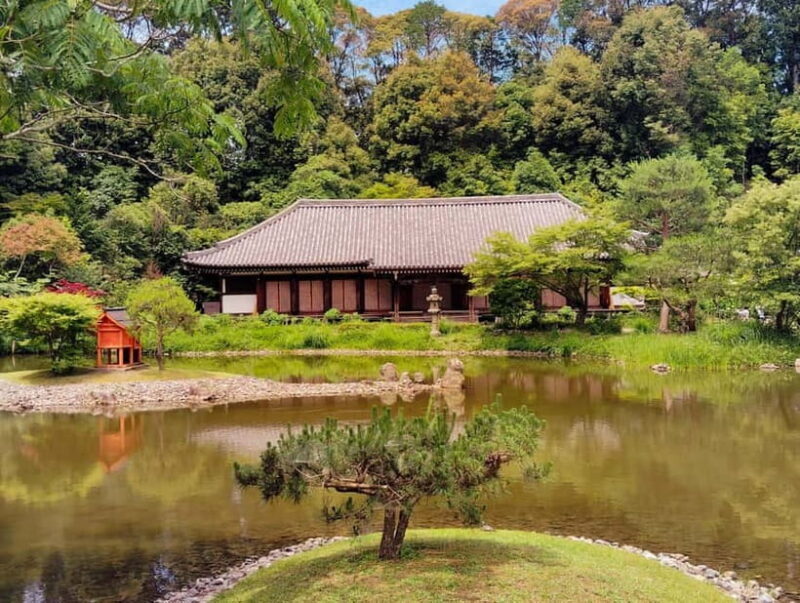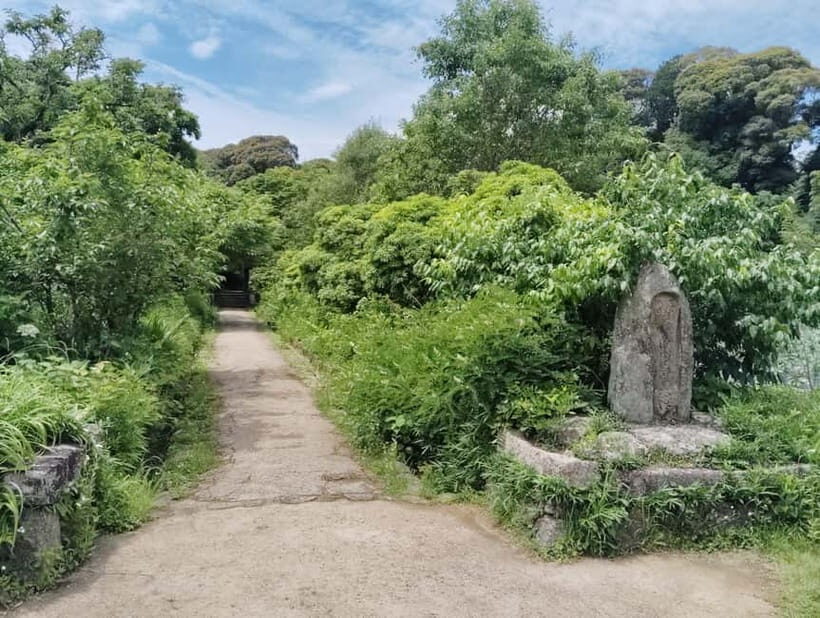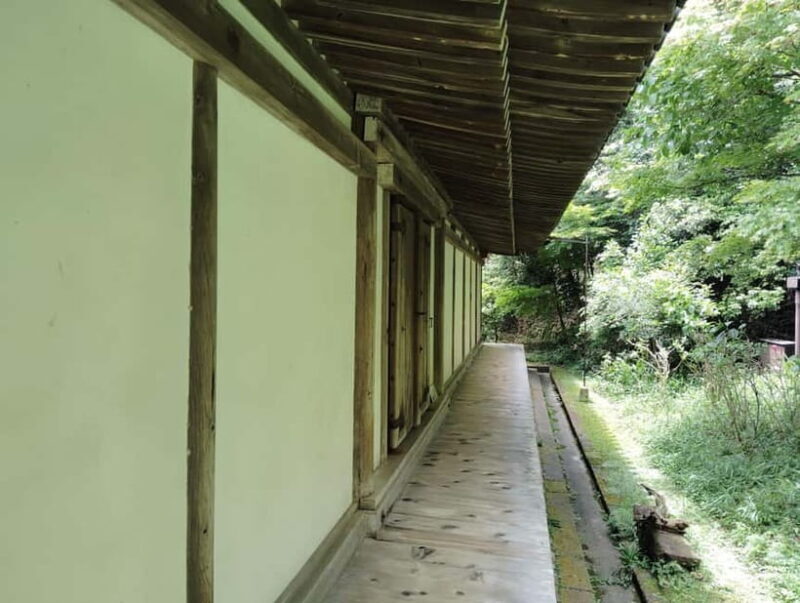Exploring Southern Kyoto: A Journey to Jruri-ji & Its Pure Land Garden
If you’re drawn to Japan’s quieter, contemplative side, this tour offers a peaceful escape into the spiritual and artistic heart of Kyoto’s outskirts. For just $64, you’ll spend about three hours wandering through the Jdo-style garden of Jruri-ji Temple with a knowledgeable guide leading the way. The tour covers the temple’s breathtaking garden, nine ancient statues of Amida Nyorai, and the history behind this unique Pure Land landscape.
What I love most about this experience is the attention to detail in the garden’s layout—a carefully crafted space designed to evoke a Buddhist vision of paradise. Plus, the hassle-free transfer service from Kamo Station makes the journey smooth and relaxing. On the downside, the tour involves walking through the garden, so comfortable shoes are a must. It’s perfect for travelers interested in authentic spiritual sites and Japanese garden design, especially those seeking a break from busier tourist spots.
This tour would suit anyone looking for a quiet, reflective experience in southern Kyoto, especially those who appreciate history, architecture, and landscape design. It’s ideal for visitors who want a guided narrative that brings the site’s significance to life, all wrapped in a peaceful setting away from the crowds.
Key Points
- Unique Garden Style: The Jdo-style garden at Jruri-ji is a rare, well-preserved example of a Pure Land landscape.
- Historical Significance: Home to nine statues of Amida Nyorai that have remained unchanged for over a thousand years.
- Guided Experience: Led by an expert, ensuring you understand the spiritual and historical context.
- Convenient Transportation: Transfers from Kamo Station make the trip hassle-free.
- Authentic Atmosphere: The site offers a genuine glimpse into Buddhist garden design and religious ideals.
- Value for Money: At $64, it provides a rich, peaceful experience well worth the cost.
A Deep Dive into the Jruri-ji Experience

Planning more time in Kyoto Prefecture? We've covered other experiences worth considering.
The Location and Layout
The Jruri-ji Temple is situated on the border between Kyoto and Nara, making it a convenient side trip if you’re exploring Kyoto’s southern corners. The temple’s grounds are small, but the garden is everything. It’s a Jdo-style garden, which means it’s designed to represent the Buddhist idea of the Pure Land—a kind of spiritual utopia. Because Jruri-ji retains its original layout, it’s a rare glimpse into medieval Japanese garden artistry.
As we approached, the first thing that struck us was the sense of tranquility. The garden’s layout cleverly integrates the temple buildings and statues into the natural landscape, creating a space that feels both organic and deeply symbolic.
The Guided Tour
Our guide, whose name I wish I remembered, was enthusiastic and knowledgeable. From the start, they explained how the garden was designed to evoke a Buddhist vision of paradise, with the central pond acting as a mirror of the heavens. The guide pointed out the Buddha statue housed in a pagoda on the eastern side, believed to be a dwelling for a Buddha residing in the Eastern realm.
One of the highlights was the nine statues of Amida Nyorai on the western side of the pond. These statues are over a thousand years old, and their preservation is remarkable. The guide explained their importance: these statues symbolize the Buddha of the Western Pure Land, a key figure in Buddhist teachings. Seeing these statues and understanding their placement in relation to the landscape helped us grasp how the Japanese interpreted Buddhist scriptures through garden design.
The Garden and Its Significance
Walking through the garden, we felt a palpable sense of serenity. The careful placement of statues and buildings isn’t just aesthetic; it’s meant to evoke a spiritual journey. The pond acts as a reflective surface, encouraging contemplation, and the pagoda offers a quiet space for meditation.
What’s fascinating is that such immersive Pure Land gardens were popular over a millennium ago, but Jruri-ji is the only one that still retains its original layout and spiritual intent. This makes it an invaluable site for anyone interested in Japanese religious art and landscape philosophy.
More Great Tours NearbyPracticalities and Experience
The tour includes bus transfers from Kamo Station, which takes the stress out of getting there. The meeting point is easy to find—just look for the yellow “DeepExperience” sign at the ticket gate. The entire tour lasts about three hours, with walking through the garden being the main activity.
Travelers should wear comfortable shoes because the path through the garden involves some walking and uneven surfaces. Don’t forget your camera—whether capturing the statues, the reflective pond, or the peaceful surroundings, there are plenty of photo opportunities.
What Past Travelers Say
Many visitors appreciated the peaceful atmosphere and the chance to see a rare, well-preserved example of Pure Land landscape design. One quote from a reviewer: “The garden is simply stunning and feels like stepping into another world.” Others highlighted the expert guidance that brought the site’s history and symbolism to life.
A common remark was how much the layout and statues helped deepen their understanding of Buddhist teachings. The guide’s explanations made the site far more meaningful than a simple stroll.
The Practical Side of the Tour

Transportation and Accessibility
The tour’s biggest convenience is the pickup and transfer service from Kamo Station. This is especially valuable if you’re unfamiliar with the area or traveling with luggage. The bus ride is brief but offers a comfortable start to your spiritual journey.
Pricing and Value
At $64 per person, it’s a modest price for a well-organized, intimate experience. Compared to larger group tours of Kyoto’s popular sites, this feels more personal. You get direct guidance, transportation, and entrance to a spiritual site that’s often overlooked. The price reflects the quality of the experience and the fact that Jruri-ji’s garden is a rare cultural gem.
Duration and Group Size
The tour lasts around three hours, making it a perfect half-day activity. The group size tends to be small, allowing for more personalized interaction and questions.
Who Should Consider This Tour?

This journey is best suited for travelers who value serenity over crowds and are interested in Japanese religious art, history, or garden design. It’s ideal for those wanting a meaningful cultural experience away from the busier temples and shrines. The physical aspect involves walking through the garden, so be prepared with comfortable shoes.
If you’re looking for a peaceful, contemplative outing that offers rich insights into Buddhist symbolism and Japanese landscape architecture, this tour delivers.
The Sum Up

The Southern Kyoto journey to Jruri-ji offers a rare chance to see and experience a preserved Pure Land garden that embodies centuries of spiritual and artistic devotion. Its layout, statues, and tranquil setting create an environment perfect for reflection and appreciation of Japan’s religious landscape.
The guided aspect ensures you grasp the significance behind each element, making the visit more than just a visual delight. Plus, the smooth transportation arrangement means you don’t need to worry about logistics—just show up and enjoy.
This tour is especially recommended for those who seek authentic, quiet spots and are interested in experiencing a different side of Kyoto’s cultural richness. Whether you’re a seasoned Japanophile or a first-time visitor, the peaceful beauty of Jruri-ji’s garden and the stories told by your guide make this a memorable, worthwhile detour.
FAQ

Is transportation included in the tour price?
Yes, the tour includes bus transfer from Kamo Station to Jruri-ji, making logistics straightforward.
Where does the tour start?
It begins in front of the ticket gate at Kamo Station, where a guide holding a yellow “DeepExperience” sign will meet you.
How long does the tour last?
About three hours, including walking through the garden and transportation time.
What should I bring?
Comfortable shoes for walking and a camera to capture the tranquil scenery and statues.
Is the tour suitable for children?
While not explicitly stated, the walking and contemplative nature suggest it’s best for older children or teens who can handle some walking and quiet observation.
Can I cancel the tour?
Yes, you can cancel up to 24 hours in advance for a full refund, offering flexibility if your plans change.
What languages are available for the guide?
Guiding is available in Bengali and Japanese, which may influence your experience depending on your language preference.
